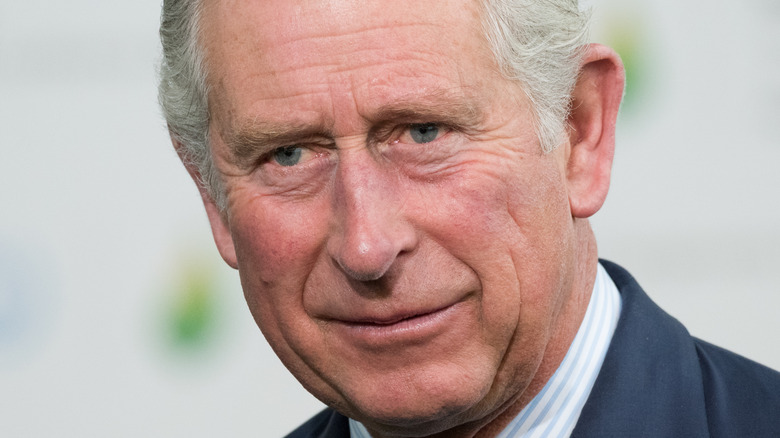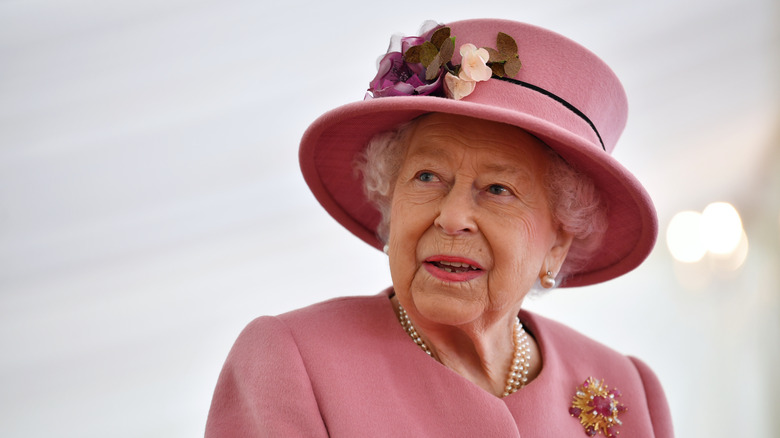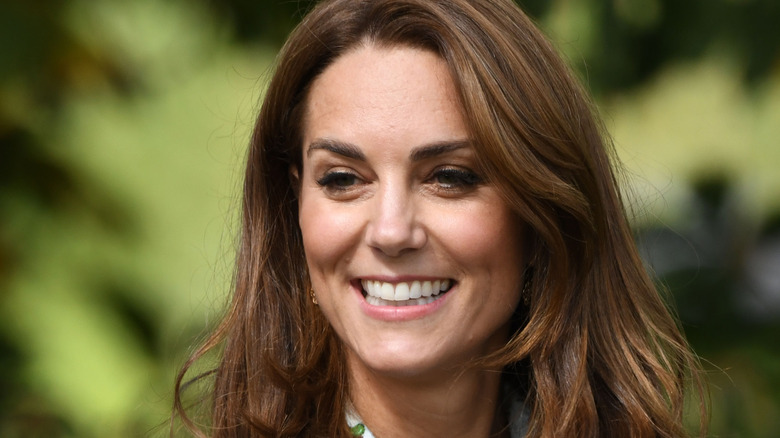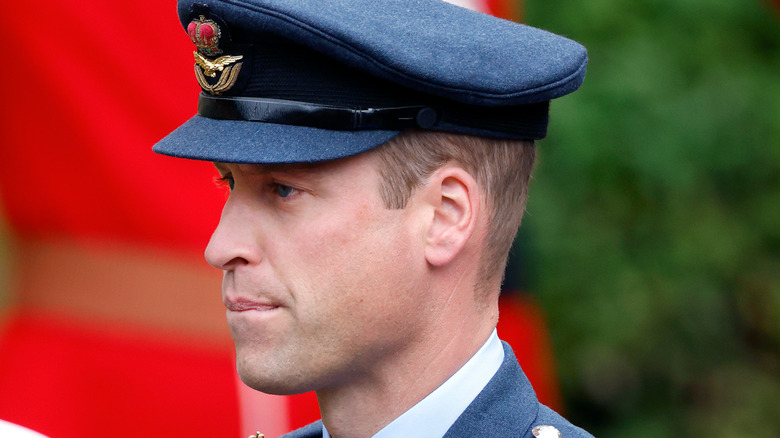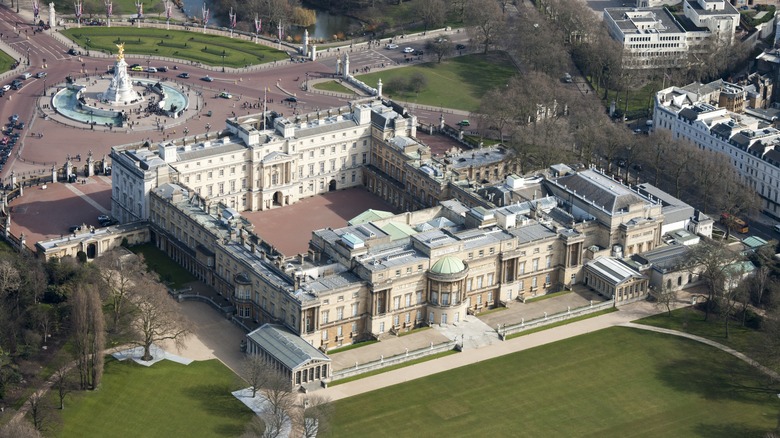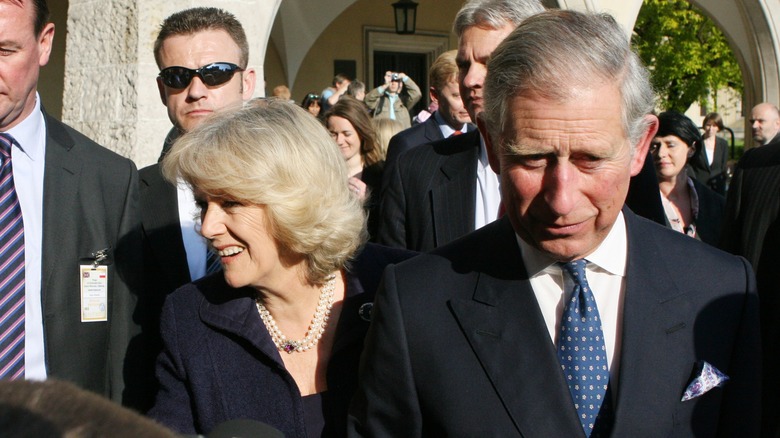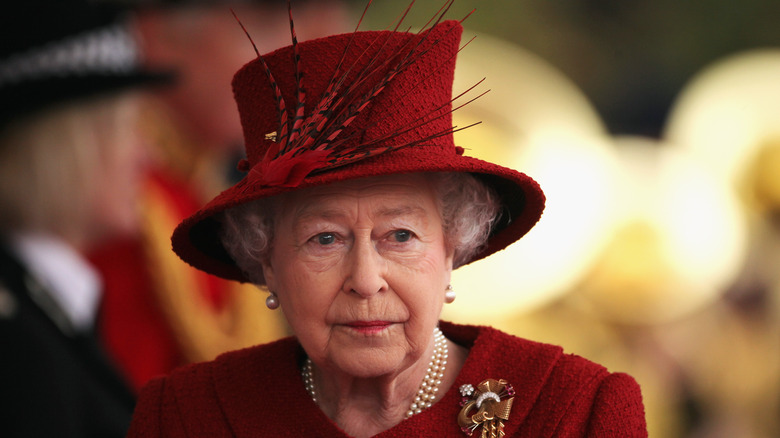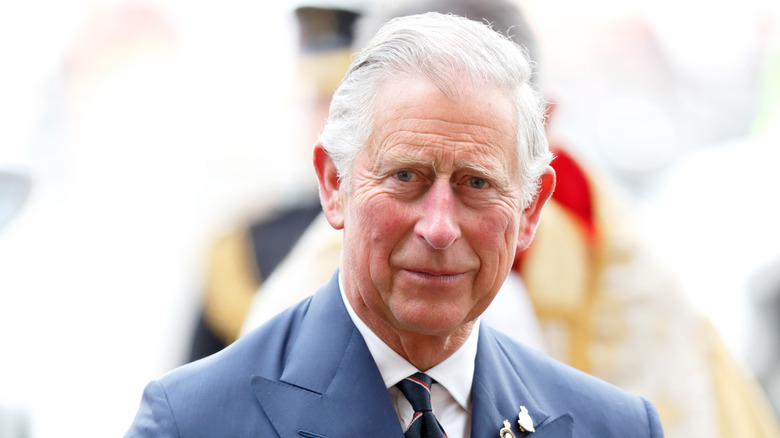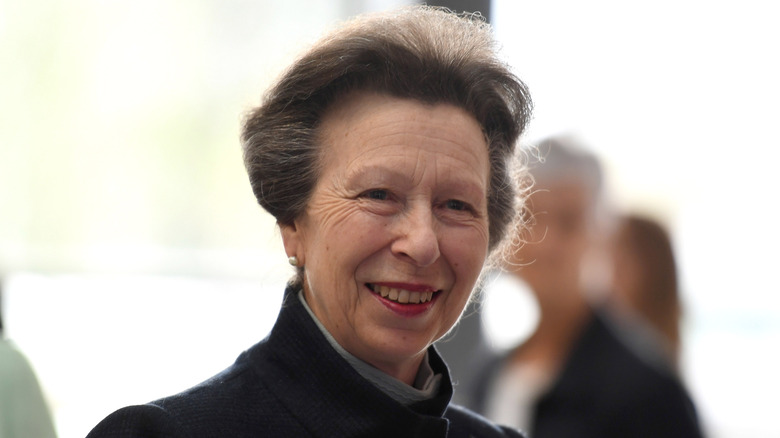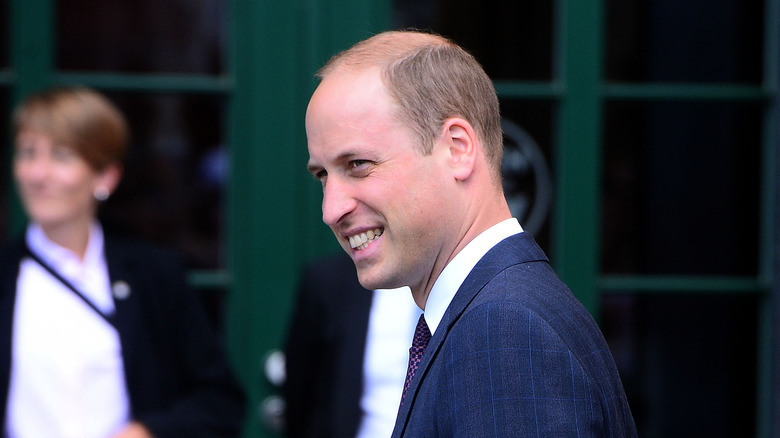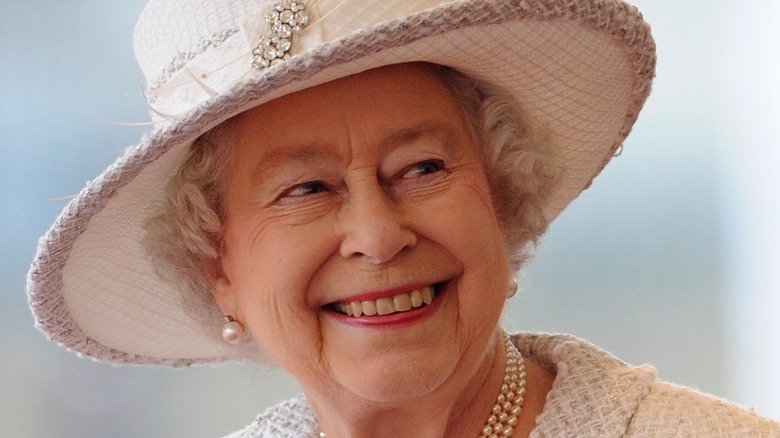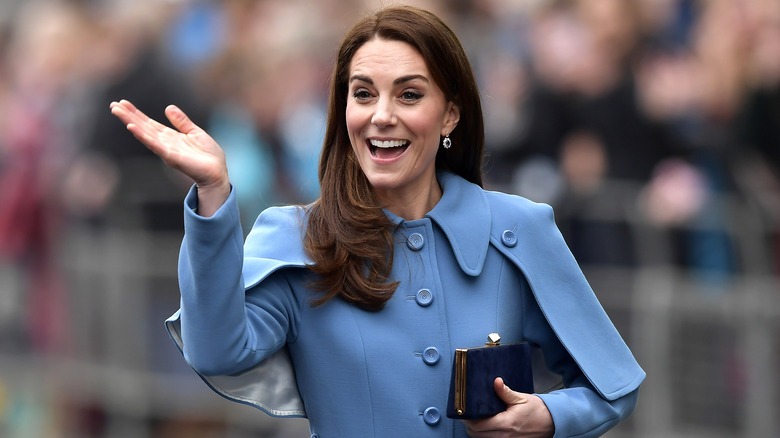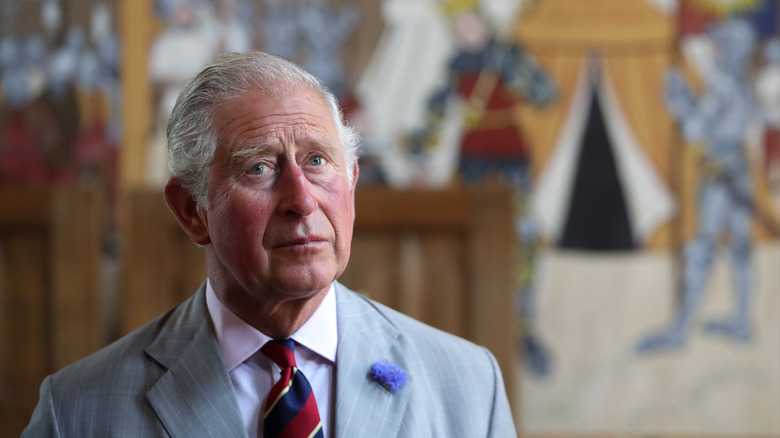Weird Rules Royals Have To Follow In The Bathroom
The more we learn about the royal way of life, the less we idolize it. Sure, there are tiaras, castles, and luxuries all around, but the list of rules, traditions, and customs is as long as a CVS receipt. How anyone remembers everything about royal life we truly don't know — who curtsies to who, how you address the monarch, how you show affection — is a never-ending cycle of traditional behavior beyond our casual intellect.
While the royal family has been in the spotlight since what feels like the dawn of time, extra attention was paid to the members of the firm in the wake of Queen Elizabeth II's passing. While the world was bracing for her death — as she was 96 and had been on the throne for 70 years — her mobility problems and later her passing still came as a huge adjustment. The royal family mourned the queen alongside the public, but while they were grieving, all eyes were dissecting their movements. William and Catherine, Prince and Princess of Wales, didn't show physical affection like Prince Harry and Meghan Markle, and King Charles III quickly drew criticism for having a tizzy over a pen. To say that the royal way of life was under the microscope was an understatement, and we wanted to learn even more about the intricacies and oddities the royals both implement and have to follow. This includes rules regarding the bathroom, getting ready, personal care, and more.
The late queen had very specific bathing rules
When it comes to rules that the royals follow regarding the bathroom, there are structures they both adhere to and implement themselves. For the late Queen Elizabeth II — who spent 70 years on the throne — she had a particular set of expectations and rules regarding her bathing ritual, broken down for the public by royal author Brian Hoey (via Women & Home).
Hoey explained that the late monarch's morning unfolded the same way every day. After waking up (in one of her palaces, of course), Queen Elizabeth's maid would draw her a bath at 7:30 a.m. — while she was waiting for the water to fill the tub, the queen would drink a cup of Earl Grey tea while catching up on the news via BBC Radio 4. No matter what residence she was staying in at the time — Balmoral, Windsor, Sandringham, or Buckingham Palace — the queen's bath would always be drawn with "tepid" water, and the maid would stop the water after an exact seven inches was poured. To double check the temperature, the maid would use a "wooden-cased thermometer" to ensure the perfect bathing water — only then would the queen step into the tub.
By around 8:30 a.m., the queen would have "fixed her hair" and put on the outfit "laid out for her" before enjoying her breakfast.
There is a very specific way that the royals must excuse themselves to use the restroom
When we sit at the kitchen or dining room table with our family for dinner — which is a more rare occurrence than a regular habit — we typically push our chair back from the table and say, "Hey, I gotta pee," before heading to the bathroom. In response, we'd get a "Bring me back a drink" from our mom and a grunt of recognition from our dad, and of course, we'd then go on our merry way. This is how it is for most people when they excuse themselves to use the restroom, but not if you're a royal. As noted by the Mirror, royals can't just quickly run to the restroom during an event or dinner but have to make a point of excusing themselves and adjusting their silverware at the table to indicate to waiters of their eating status.
Before a royal is to get up from the table, they cannot "announce their intentions" but rather they must say, "Excuse me," and quietly leave. Before they make their way to the nearest restroom, they must cross their fork and knife on their plate if they're not finished eating. If the royal is finished with their meal, they can leave their silverware "at an angle, with the handles at the bottom right of the plate."
Men must be clean-shaved in the royal family, no beard shaving over the sink
Every person who lives with a man knows the struggle of walking into the bathroom and seeing beard hair in the sink — and somehow, it always seems to appear right after you've deep cleaned. When it comes to the bathroom and personal hair care, royals are expected to keep their facial hair to a minimum (and we can expect that they likely get their faces shaved for them rather than using an electric razor over the sink like a normal person). Getting a shave at a specific barber's – or by a professional — is undoubtedly considered a luxury, and when it comes to the royals, nothing but the best will do.
As noted by The Scotsman, it is customary for royal men to be clean-shaven, and none of the royal family members wear a beard on their wedding day or at special occasions. Of course, there is one exception — Prince Harry, Duke of Sussex. The Scotsman noted that for Harry to appear with a beard and in military uniform — as he was seen on his wedding day and during many official appearances — he had to be given permission from Queen Elizabeth II. Talk about a personal hair rule that we didn't see coming.
Royal cleaners are not allowed to vacuum the bathrooms
There isn't a week that goes by when we don't vacuum our bathroom. From the amount of hair that falls out of our heads (which is concerning, to be honest) to fluff from cotton pads to just general dust, the bathroom floor can get pretty cluttered throughout the week. Where would we be, then, without the Dyson sitting in the hall closet? And while just clicking the extension onto the vacuum, plugging in, and pressing on is the cleaning habit most of us are used to, such a practice is not permitted in royal households.
The royal website notes that there are 78 bathrooms in Buckingham Palace alone, and household staff is not allowed to use vacuums to keep the floor tidy. That's right. As noted by Hello! Magazine, vacuums are not permitted in the household, but rather maids and servants must "sweep the floors and carpets." As discovered in the documentary "Royal Servants," the household cleaning item is not allowed in the royal halls given the disturbing noise it omits. "Cleaners sweep carpets, lest royal ears are offended by vacuum cleaners," the documentary asserted. "The best servant is one that is neither seen nor heard."
Royals can't use a specific word to describe the restroom
Language is critical in the royal family. The firm members are always poised, articulate, and never insulting. The rules regarding language are so extensive, however, that they apply to vocabulary that we wouldn't have even thought of ourselves, and those specifications go as far as the language used to describe the bathroom. As noted by The Sun, the late Queen Elizabeth II did not find the word "toilet" appropriate for polite conversation. Instead, the words "lavatory" or the British colloquialism, "the loo," were reasonable alternatives. And while the queen is no longer with us, this rule is unlikely to change.
Why the specification? Why is the word "toilet" banned from the royal conversation? Well, as it turns out, the term "toilet" stems from the French language and, as such, is "frowned upon in royal circles." Could we catch ourselves and make sure we ask for the "lavatory" rather than the "toilet?" It remains to be seen.
Of course, the language rules extend to much more than the restroom. As noted by Harper's Bazaar, words such as "living room," "lounges," "dens," and "perfume" are not permitted. Regarding furniture, couches must be referred to as "sofas," among other oddities. What's the difference? Honestly, we're not sure.
The royals have a specific perspective on showers
There's nothing quite like getting home from a long day in the office, turning on the bathtub, and sinking into the bubbles with a book and a glass of wine. It's a relaxing ritual that feels like a special, once-a-week treat, but when it comes to the royals, bathing is a customary practice that stands in place of showering. As aforementioned, Queen Elizabeth II had very specific bathing rules that were followed on a daily basis — relating to the water temperature, water height, and more — and she wasn't the only royal to have structured self-care. As noted by Woman & Home, the late queen, her sister Princess Margaret, and other royals saw showering — instead of bathing — as a practice for the busy common person, preferring a bath over a standing shower any day. Royal expert Craig Brown further explained the odd bathing rule and perspective.
"[Princess Margaret] always took a bath because she and other royals believe showers are for people who are rushing out the door to get to work," Brown revealed. Rather than quickly jumping in the shower before running off the work, royals saw bathing as a more luxurious way to keep themselves clean, opting for the practice daily.
King Charles III has very choice bathroom rules, even when traveling
Of all the royals people closely watch, King Charles III occupies a spotlight that is rivaled perhaps only by Prince Harry and Meghan Markle. The newly named monarch, though, doesn't always hit the headlines for the most flattering of reasons — even during his first week on the job, King Charles III had an outburst regarding a pen that circulated widely on social media (and you can imagine what people were saying about the "pampered prince"). His oddities and specific rules of engagement far exceed the spaces that the public can observe and apply to his bathroom rules as well. As written by Tina Brown in her book "The Palace Papers" (via Page Six), King Charles has specifications applying to his toilet seat, the kind of toilet paper he uses, and what must be in tow when he travels. But wait — the royals can't use the word "toilet." Lavatory seat? Lavatory paper? It just doesn't flow off the tongue nearly as well.
Brown was given specific information about Charles's bathroom rules by his former aide, Michael Fawcett, who revealed that the king requires bathroom "paraphernalia" such as his own "lavatory seat" (that he requires to have with him when he travels) and "Kleenex Velvet lavatory paper." The bathroom essentials were even part of a truckload's worth of personal items that traveled with the king, even when staying at a friend's home in the country.
Members of the royal family aren't allowed to have reading material in the bathroom
We're going to require a moment of honesty from you all — how many of you take your phone or a magazine into the bathroom with you? If you said no, we know you're lying. A study conducted in the United Kingdom found that men, in particular, spend about seven hours a year on the toilet (that is just ridiculous), and 84% of those surveyed admitted to browsing through social media while doing their... business. But if you're a royal family member, you can't abide by such typical restroom habits. No phone, newspaper, or magazine — in fact, reading material is seen as "unhygienic" while sitting on the porcelain throne and, as such, is not permitted in the royal restrooms, per House Beautiful.
Such odd rules extend further past reading material. House Beautiful notes that candles are not standard in royal bathrooms, nor are products like a diffuser (and if there is one, it should be hidden when guests are over). There must be a neatly folded stack of white hand towels for people to use while visiting the royal home, and toilet paper must be placed on the roller to come from the over position, not under — sorry, lavatory paper.
The royals can't eat shellfish for ... lavatory reasons
Some foods people know don't agree with their systems. For quite a few of us out there, it's dairy — for others, it's nuts. Whatever the food, many of us know what to stay clear of when it comes to our own bodies. And while the royal family members might have the well-being of their relatives in mind when it comes to foods to avoid, this bathroom rule takes the cake. According to former palace chef Darren McGrady, some foods typical in fine dining cuisine are simply off the table for the royals, having been deemed too "risky" (via Marie Claire). These foods include shellfish and foie gras, and while we can get behind the no foie gras rule, who wants to skip the shrimp cocktail during happy hour?
So why no shellfish, in particular? Former butler for the royals turned etiquette expert Grant Harrold explained that it has to do with timing and not getting an upset stomach while on the job (which would likely have a royal screaming, "Where's the toilet?" without giving much thought to the language being used).
"When dining, the royal family has to be careful with shellfish due to shellfish poisoning due to their work schedules," Harrold explained to the Daily Express. "Therefore, you will not normally find this on the royal menu."
The queen had a very specific personal hygiene rule
Of all the working royals, the late Queen Elizabeth II made it clear that even her age and mobility problems wouldn't keep her away from the task at hand. Just a few days before her death, the queen met with Britain's new prime minister, Liz Truss, to ensure the transfer of political power. No such event was off-limits for the queen, and her commitment to the job ensured yet another bathroom and personal hygiene rule she stuck to regularly.
As noted by Marie Claire, Queen Elizabeth II made a point to wear gloves while out and about. Given the amount of handshaking she engaged with, gloves gave the late monarch a layer of protection between herself and someone who might be ill or dealing with a bad case of allergies while greeting Her Majesty. Such a commitment to gloves as a royal has only been broken — in a high-profile way, that is — by Diana Spencer, whose personal style and dedication to the common person transcended gloves on many occasions.
And such rules about gloves and personal hygiene even extended to how the queen and royals take off gloves as well. To remove the gloves, a royal must take them off one finger at a time, then place the set gingerly on the lap beneath the napkin you're likely using.
Royals likely don't use liquid soap
Take a moment to think about the hand soap aisle in Target. From Mrs. Meyers to Everspring to Method, there are some great options out there that are a little on the fancier side. If you really want to go all out, a bottle of Aesop liquid hand soap can set you back about $40. But never mind the price — when it comes to the royals, no liquid soap will do, even if it's the most expensive and luxurious on the market.
Royal etiquette expert Myka Meier spoke to House Beautiful about the hosting and bathroom habits of the royals, and she should be the expert worth listening to, given that she attended finishing school in the United Kingdom. And as it so happens, royals likely use bar soap over liquid, with Meier explaining why a duchess like Catherine Middleton would never have a pump bottle in the bathroom — even if it is Aesop.
"The duchess will also probably have lightly scented soap and paired hand cream," Meier explained. "Many upper-class British homes prefer bar soap to liquid, so the duchess may use that in her private quarters." So why the bar? There's less temptation to use multiple pumps, or maybe it's just classier. We're not royal, so who's to say?
King Charles has very specific bathroom requirements
King Charles III knows a thing or two about being raised in a palace, and it appears that some of his personal hygiene habits have not advanced past childhood. In fact, a former butler to Diana Spencer, Paul Burrell, revealed that the now-king has a very specific set of bathroom rules — and we thought the velvet lavatory paper (see what we did) was bad enough. As noted by GoodToKnow, Burrell claimed that when it comes to the king's bath every day (yep, the aforementioned ruler applies to him too), the bath plug must be placed in a particular position, and the water temperature has to be the perfect degree of "tepid" — which typically has 98°F as the highest threshold. There are some details about the king's bathroom rules, but we must let Burrell explain them in his own words.
"[King Charles III] has his valets squeeze one inch of toothpaste onto his toothbrush every morning," the former butler said. Yet another expert, royal biographer Anthony Holden, further commented on the royal's means of getting dressed, saying, "Charles, for all his attempts to find out how the other half lives and interest in the less fortunate in society, for all that, he has two men, paid for by the state, to help him get dressed in the morning."
